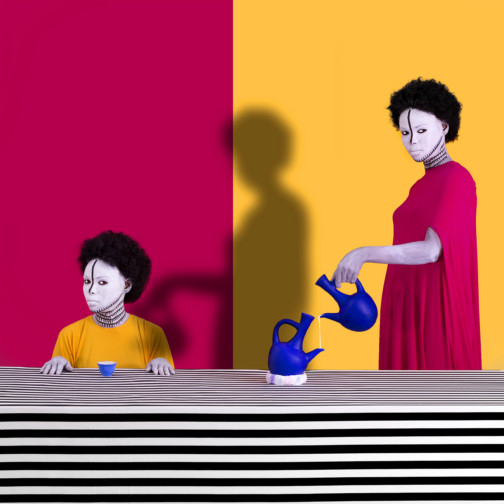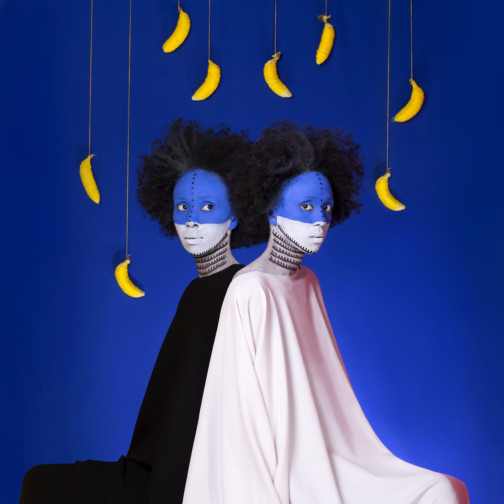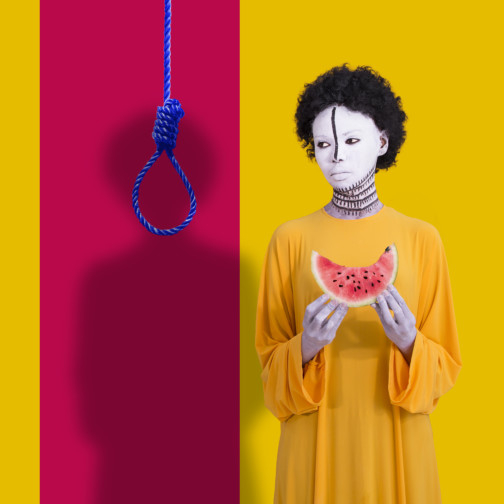Photographer Aida Muluneh’s first solo show in Dubai, The Memory of Hope, expresses her feelings, both as an African and as a woman about the increasing racism and intolerance in contemporary society, and the impact of capitalism on developing countries. Through her colourful cinematic compositions the artist makes strong statements about the socio-political issues and injustices that have made her question her belief in what is right and wrong, reducing the optimism of her youth to a distant memory of hope.
Muluneh was born in Ethiopia, spent her childhood in Yemen, England and Cyprus before settling down in Canada in 1985. She studied filmmaking in the US and began her career as a photojournalist for the Washington Post. Since 2007 she has been based in Addis Abbaba, where she organises a photography festival and has founded an initiative called Developing and Educating Society Through Art (DESTA). Her work has been exhibited across the world and acquired by prestigious museums. She has recently been invited to participate in a group exhibition at the MoMA in New York titled, Being: New Photography 2018.
In her latest work, Muluneh has used a vocabulary of primary colours, subtle shadows and gestures, traditional body markings and a variety of symbolic objects to express herself. The main characters in her staged photographs are African women with tribal markings on their faces and necks, but her images comment on African as well as global issues.
Muluneh spoke to Weekend Review about her concerns and how she has addressed them in her work. Excerpts:
What is the concept behind this body of work and its title?
When I was young I was confident about what was right and wrong, and optimistically believed that if I did the right thing and was good, then the world would be good to me. Having lived in many countries, I always look for what is common between people rather than focusing on the differences. But all around me I see cultural and religious intolerance, which is based on a false sense of superiority, and the exploitation of the weak and underprivileged by the rich and powerful. Today people have forgotten how to be kind, thoughtful and hopeful. The ironic title of my show recalls the innocence and optimism of my youth, and reminds us not to forget our values and humanity and not to lose hope. Through these works, I want to highlight the things we refuse to hear and see and compel us to question ourselves so that we can find solutions to the collective challenges we face.
What is your creative process?
I approach each shoot like a film production. I make detailed story boards and incorporate many elements from my culture in the work. For this series, I have used black, white and primary colours and worked with fashion designers and hair stylists to recreate Ethiopian styles from the 1930s and 40s. The markings on the face and neck of the model include traditional markings from different parts of Ethiopia and other countries as well as my contemporary improvisations. My images depict women because I can tell my stories only from my perspective as a woman.
What do you want to convey through The Amusement at the Gate?
This work uses coffee, which is a big part of Ethiopian culture and resources to talk about African dependence on so-called Western aid. A woman is pouring coffee from a traditional Ethiopian coffeepot or jebena into a replica of the pot while another woman waits with an empty cup or sini in her hand. A shadowy figure in the background seems to be pouring coffee into the cup that remains empty. This image represents what happens with the aid that is supposed to help us, and conveys the idea that instead of waiting for others to help us, Africans must find solutions for their own problems.
Does The Mirage of Hope also express a similar idea?
We have all seen how African migrants who left their homelands in the hope of a better life are suffering, and I feel that we need to have a new conversation with regards to migration. Africans must realise that no place is perfect and rather than chasing the mirage of seemingly better foreign lands, they should think about finding ways to improve their life in their own countries.
What is the symbolism of the bananas and watermelon in Both Sides and The American Dream?
It is sad that these ordinary fruits have become charged with racist connotations. African footballers and other sportsmen playing in European leagues are often humiliated by bigots in the audience who throw bananas at them. After the abolition of slavery in the US, when freed slaves began growing watermelons to generate income, the fruit was used as a symbol for oppressing and ridiculing them. Both Sides questions the American president’s statements equating both sides in the racial conflict in Charlottesville. It features two women, dressed in contrasting black and white robes seated with their backs to each other. The bananas hang like crescent moons over their heads highlighting the disturbing fact that race and religion still play such a significant role in our daily lives. In The American Dream, my model is holding a juicy slice of watermelon but with a fly perched on it, while a shadowy figure behind her with a noose around its neck signifies the lynching of black people in the 1930s, drawing parallels with the racial tensions currently prevailing in the country and globally.
Why did you use South American body markings in Captive Conscience?
These works are dedicated to Berta Caceres, the Honduran environmentalist who was killed last year. She was fighting against large corporations involved in building a dam, to protect the environment and the rights of ordinary people who were affected by the project. She represents the power of women around the world who are breaking free from the restrictions imposed on them by society to stand up against injustice and fight to make this world a better place.
What do the Arabic words on the woman’s robe signify in Seeds of the Soul?
This work is my dedication to Islam and the word written on the dress is ‘peace’. All religions teach the values of love, truth, peaceful coexistence and being good human beings, so it is sad that Islam is being misrepresented today, and people are being persecuted because of the misconceptions about it. This work was inspired by Norman Rockwell’s portrait of an African-American girl being escorted to an integrated school by armed policemen with racially abusive posters in the background. It was titled The Problem We All Live With and became an iconic image of the Civil Rights Movement in the US in the 1960s. It is a shame that we are still living with this problem, and people are still being persecuted for the colour of their skin or their religious beliefs.
Jyoti Kalsi is an arts-enthusiast based in Dubai.
The Memory of Hope will run at Gulf Photo Plus in Alserkal Avenue, Al Quoz until December 9.















